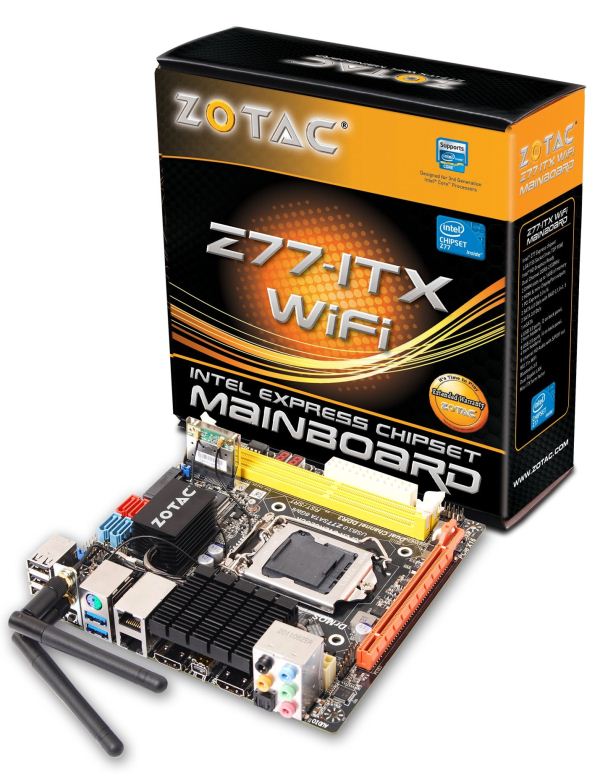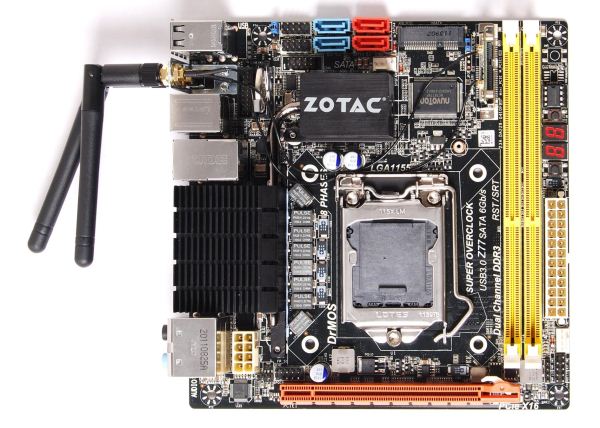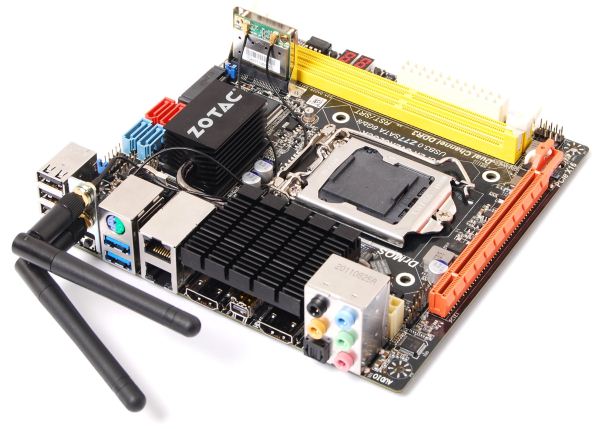Z77 mITX Round-Up: Five of the Best – MSI, Zotac, ASRock, EVGA and ASUS
by Ian Cutress on December 31, 2012 7:00 AM EST- Posted in
- Motherboards
- MSI
- ASRock
- EVGA
- ZOTAC
- Asus
- Ivy Bridge
- Z77
- mITX
Zotac
If you ever wanted small form factor, then Zotac has always been an option, sprouting mITX products for every platform and chipset. With Ivy Bridge and 7-series platforms, Zotac has announced three products so far – two H77 motherboards (-A-E and -B-E), and this motherboard, the Z77-ITX WiFi (also known as the Z77-A-E).
Historically Zotac has not had the ability to innovate as much as the key players in the motherboard industry. Part of this is down to the 'real estate on the PCB of a mITX' factor – the chipset specification deals with a significant amount of the actual hardware on board, but part of it is also due to the size of the company in correlation to their R&D. In this context Zotac fit in the same niche as Biostar – whatever we do see in terms of innovation is few and far between. However every now and again we are pleasantly surprised, as long as it fits into the correct price bracket.
With that, let us start with the Z77-ITX WiFi.
Zotac Z77-ITX WIFI Overview
When testing the Zotac Z77-ITX, I initially ran through the benchmark suite with a high end i7-3770K, and again recently with an i3-3225. In terms of performance, there were several key factors worth noting, such as the slightly slower times in our WinRAR testing compared to other Z77 products. This test relies on the motherboard to apply turbo multipliers given varied load – it is a test that top tier manufacturers seem to do well in, but the lesser manufacturers fall behind. On the plus side, we get a fast POST time (9.18 seconds with a discrete GPU installed), low power usage (20W long idle on a 500W Platinum PSU with a discrete GPU installed, 32W idle) and a sub-200 microsecond DPC Latency test.
Hardware wise, Zotac take a different tack to the video outputs compared to the rest of the Z77 crowd. The Z77 platform with an Ivy Bridge processor allows for 3 digital display outputs and one analogue; most motherboard vendors take this to mean ‘we want one of each output’. Zotac, like Gigabyte, decided to make two of these outputs HDMI to cater for the majority of dual screen home setups (or to supply audio out of one and video out of the other). Rather than give a combination DVI-I port, Zotac also equipped the board with a mDP port and placed in the package a mDP to DP adaptor. If you want a modern digital connection from a Z77 mITX board, Zotac has you covered.
Also relating to hardware, Zotac have given this board a dual NIC as well as WiFi on board, giving network connectivity a high priority. On the downside, we only get a Realtek ALC889, which also failed our RMAA 192 kHz test. The USB 2.0 copy times were quite low, but improved while the CPU was under load, suggesting that some of the BIOS default options are not optimal for USB transfer. The big BIOS option faux pas however is the reluctance for Zotac to move into 2012 and enable AHCI on their SATA ports by default. Also, if you were looking for software for OC or fan control software, unfortunately you will not find them on a Zotac board.
The Zotac Z77-ITX is currently fluctuating wildly in price. When I started the testing for this review, it was at $130. I now see it on Newegg for $163. For the former, it warrants a consideration when weighing up the pros and cons between which Z77 mITX motherboard to choose – having all those extras in the box helps sweeten the deal if you can overlook some of the possible issues.
Visual Inspection
As one of the first Z77 ITX motherboard on the test bed, it is hard not to notice the arrangement of the motherboard as a whole. The location of the socket is very close to the PCIe connector – with the limitations of the mITX platform, the Intel minimum specified distance of components away from the socket (marked by the white box around the socket) is adhered to but only just. This comes into play when we deal with different air coolers on such a platform.
Typically with a Z77 motherboard we see the chipset and additional IO chips to the south of the memory slots, but there is no such luxury on the Zotac Z77-ITX WiFi – we have the chipset located above the CPU, along with our SATA connectivity. In terms of SATA ports, Zotac uses the two SATA 6 Gbps and two SATA 3 Gbps from the chipset for direct SATA connections – another of the SATA 3 Gbps from the chipset is used for the mSATA port to the right of the SATA ports. This should leave one more for an eSATA port on the back IO, but we find no eSATA port.
Fan headers on board are oddly positioned – with a mITX platform I would expect at least two, if not three, and we get two 4-pin headers here. We find a CPU header on the right hand side below the 24-pin ATX power connector and a 4-pin SYS header between the chipset heatsink and the SATA ports. A lot of the space on the right hand side is taken up by the full length DDR3 memory slots – in the past we have seen Zotac switch them out for SO-DIMM memory ports, which could always be an idea for this platform (or if possible, angled SO-DIMM on the back of the board (?)).
The heatsink arrangement for the Zotac covers the chipset above the socket, and the VRM. Zotac have decided to extend the heatsink over the IO panel due to their back panel port arrangement. Even with the fan headers, this should help with cooling if the system were to be pushed with a high wattage chip and an overclock.
The location of the 8-pin CPU power connector is a little odd – we find it on the bottom of the board below the heatsink for the power delivery. This means that any power supply would need to reach over parts of the board in order to connect in. Zotac get around this by including an 8-pin CPU power extension cable in the box, but that still leaves the fact that a cable is somewhere potentially blocking airflow.
Other features directly visible on the board are the mSATA port and the WiFi module, both located above the CPU socket and to the right. The WiFi card is perpendicular to the board itself, and runs two small cables to antenna ports on the back panel – I personally found these cables a little annoying when trying to plug peripherals in to the ports when the board was fixed in a case.
The mSATA port is something that will crop up on mITX boards from now on, providing the possibility of running a smaller form factor if you want to pick up an mSATA SSD. As mSATA densities get higher, this will become more viable for Windows users (where Windows 7 x64 Ultimate requires a drive more than 32GB).
Also on board are various headers for the front panel, the front panel audio, two USB 2.0 headers, a USB 3.0 header (found near the IO), a two-digit debug LED and power and reset buttons. The location of the USB 3.0 header is strange, as in a mITX platform it would more likely be for a front case connector or a separate USB 3.0 panel. It is nice to see a debug LED on board however – I did have to use it a couple of times to determine why the board was failing to boot.
On the back panel, the IO is slightly odd compared to other Z77 motherboards we have encountered. First up is a block of four USB 2.0 ports (I like blocks like this as it gets a lot of USB connectivity sorted), a pair of antenna slots, a ClearCMOS button, a PS/2 combination port, two USB 3.0, dual Realtek NIC, dual HDMI, mini-DP, optical S/PDIF output and audio jacks. The dual HDMI is an interesting addition, as it involves in internal conversion from the DVI port to a HDMI. I wonder if there is scope for this on more mainstream Z77 motherboards, whereby video output is organized in a single IO stack of HDMI, mDP/DP, HDMI. Given our past reviews, the Gigabyte H77-ITX certainly has an inkling with their dual HDMI setup.
Board Features
| Zotac Z77-ITX | |
| Price | Link |
| Size | Mini ITX |
| CPU Interface | LGA-1155 |
| Chipset | Intel Z77 |
| Memory Slots |
Two DDR3 DIMM slots supporting up to 16 GB Up to Dual Channel, 1066-2133 MHz |
| Video Outputs |
2 x HDMI mDP |
| Onboard LAN |
2 x Realtek 8111E 1 x WiFi Module |
| Onboard Audio | Reaktek ALC889 |
| Expansion Slots |
1 x PCIe 3.0 x16 1 x mSATA 1 x mini-PCIe (occupied by WiFi module) |
| Onboard SATA/RAID |
2 x SATA 6 Gbps, Supporting RAID 0, 1, 5, 10 2 x SATA 3 Gbps, Supporting RAID 0, 1, 5, 10 1 x mSATA / mini-PCIe |
| USB |
4 x USB 3.0 (Chipset) [2 back panel, 2 onboard] 8 x USB 2.0 (Chipset) [4 back panel, 4 onboard] |
| Onboard |
2 x SATA 6 Gbps 2 x SATA 3 Gbps 1 x USB 3.0 Header 2 x USB 2.0 Headers 2 x Fan Headers 1 x mSATA / mini-PCIe 1 x Front Panel Audio Power/Reset Buttons Two-Digit LED Debug |
| Power Connectors |
1 x 24-pin ATX Power Connector 1 x 8-pin CPU Power Connector |
| Fan Headers |
1 x PWR (4-pin) 1 x SYS (4-pin) |
| IO Panel |
4 x USB 2.0 2 x Antenna 1 x Clear CMOS 1 x PS/2 Combination Port 2 x USB 3.0 2 x Realtek 8111E GbE 2 x HDMI 1 x mDP 1 x Optical SPDIF Output Audio Jacks |
| Warranty Period | 3 Years |
| Product Page | Link |
On the pure hardware side, apart from the arrangement of the socket area, we could call Zotac out on one or two design issues. The lack of an analogue output, even in the modern era, could be an oversight – this all comes down to the design of the package. We also only have the Realtek ALC889 audio codec, rather than the ALC89x series, and for some reason it fails the RMAA 192 kHz test. It is worthy of note however to mention the dual NIC + WiFi which is rare on a mITX board, as well as the presence of power/reset buttons in conjunction with a two-digit debug LED, useful for troubleshooting.














54 Comments
View All Comments
Bullwinkle J Moose - Monday, December 31, 2012 - link
Hey yeah, Ian haz a good pointThat Crappy Gigabyte H61n-USB3 doesn't have Chipset USB3
But it does however boot just fine to a USB3 Windows to go drive at USB3 speeds
It also boots to Linux and XP due to the Non-Locked down Bios so we wouldn't want that either would we
and it takes a full 9 seconds to boot XP compared to the super de duper fast 7 second Windows 8
So we should spend more money and get locked into a closed system
After all, that is the future!
Limitations are fun so be happy as we lock down the Internet as well
After all, there are scarey Monsters out there
A man has to know his limitations
Clint Eastwood
Bullwinkle J Moose - Monday, December 31, 2012 - link
Ian haz a good point about the memory tooThat Gigabyte H61 board only takes up to 16GB of RAM
How much do these Z77 boards take by the way?
Was it this site or Maximum PC where the reviewers stated that in everyday use, you will notice no difference in speed between Sata 2 & 3 when you are using the latest and greatest SSD so I probably don't need the RAID capability on my H61 either
Keep up the good work Ian
Death666Angel - Wednesday, January 2, 2013 - link
It seems that someone just discovered sarcasm. Good for you!mczak - Monday, December 31, 2012 - link
H61 is not limited to one single sided DIMM per channel, double sided are just fine. It only accepts one per channel (at least it's specced that way) but since none of these mini-ITX boards have more than two memory slots this wouldn't matter at all here (max memory is still 2x8GB regardless).Frankly I'm not sure losing PCIe 3.0 is a big deal with mini-itx boards in any case but either way it isn't exactly true there are h61 boards supposedly supporting this (as it's got nothing to do with the chipset anyway all the pcie 3.0 signals coming directly from the cpu, though it would require bios support).
This leaves us with losing SATA 6 Gbps - this might indeed make some minimal difference in real world, provided you use a SSD and not a HD.
The major point imho (aside from overclocking) would be missing USB 3.0, which obviously makes a big difference when using external harddisks etc. Granted that could be done with separate usb controller but probably not a good idea since space is limited.
H61 IIRC also will lose the possibility of using 3 display outputs simultaneously. Maybe something like H77 would make more sense for mini-ITX as it pretty much only loses overclocking (plus the ability to split the 16 x pcie 3.0 lanes into 2x8 though I guess this has nothing to do with the chipset itself really, but in any case it won't be missed on mini-itx). So if you don't want to overclock, you wouldn't miss anything at all with H77 on a mini-itx board.
Etern205 - Saturday, January 5, 2013 - link
I also notice that as well, most sites will only review Z77 mITX boards instead of H61 or H77. Not all will need a Z77, Z77 is mostly for enthusiast or for those who are into the technical stuffs. For the average Joe or Jane any mITX board will do. If you tell them it's H61 or Z77, they probably won't care too much on the difference.piroroadkill - Wednesday, January 2, 2013 - link
You can't easily upgrade the chipset later. With a small up-front investment, you get the full feature set, and why not?Bullwinkle J Moose - Sunday, January 6, 2013 - link
Oh Boo Hoo, I can't easily upgrade to an overclocking chipset or void the warranties of my hardware componentsI am just stuck with a totally stable system
Boo Hoo
How can I possibly break this ?
What has the World become ?
Poor me
Boo Hoo
Bullwinkle J Moose - Sunday, January 6, 2013 - link
Why not?Because the H61 is exactly what I wanted
and anything else is NOT !
can you hear me now?
EVGA KINGPIN - Friday, November 19, 2021 - link
I still use my Z77 FTW board , have had it running without turning it off since 2015. evga is the best ,also my EVGA GTX 980 KINGPIN is still running strong,,,thanks EVGA for quality products, JRTsherlockwing - Monday, December 31, 2012 - link
Where is the Gigabyte?